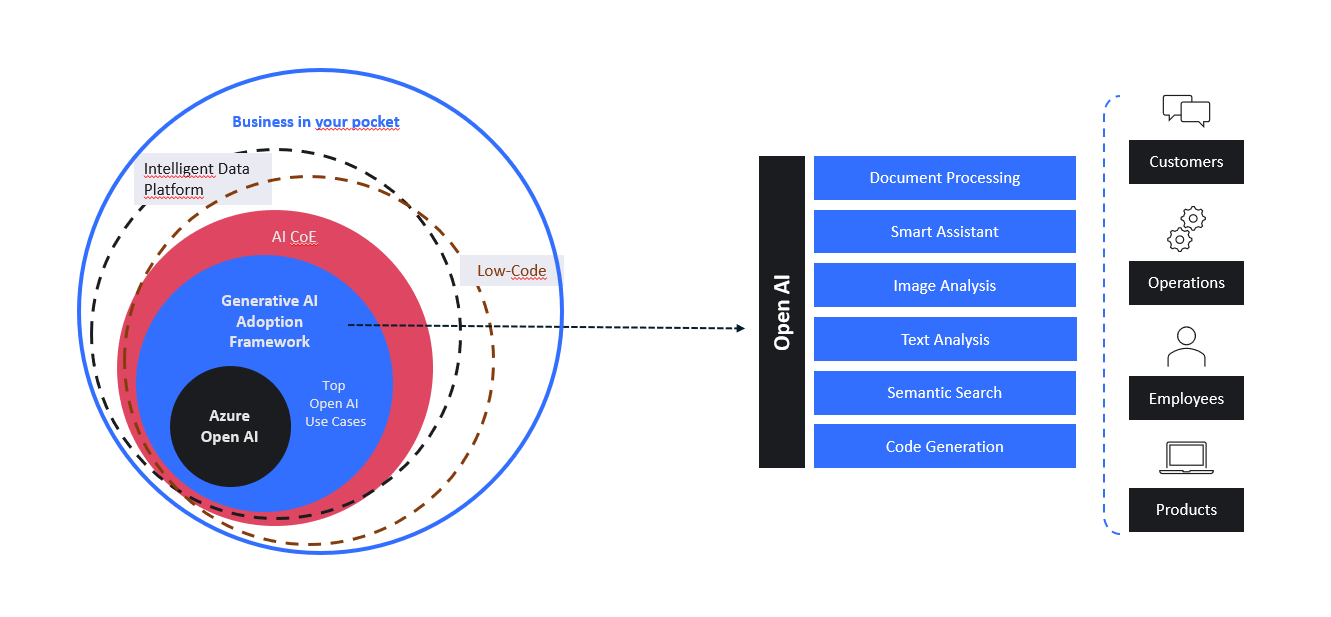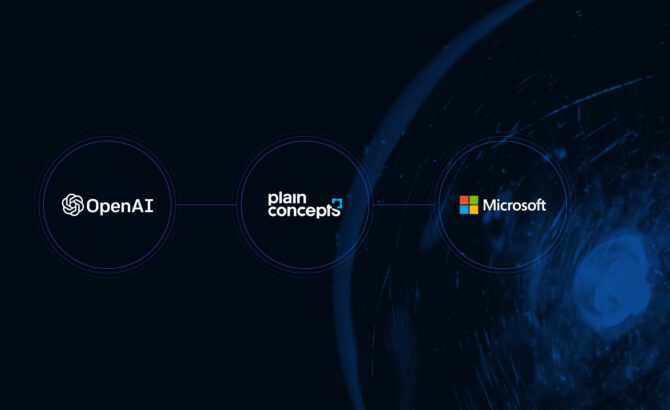Elena Canorea
Communications Lead
Over the last few months, we have witnessed what we could call the “boom” and global expansion of generative AI. The significant advances in this technology, as well as the novelties of OpenAI, ChatGPT, and its countless applications, are making it the most talked-about term of the moment.
“Managers need to be informed about the state of the art of generative AI and adopt a proactive mindset to integrate the technology into their business. We are facing a technological revolution that, used with a strategic vision, can generate opportunities for optimization, cost reduction, new business opportunities, and better decision-making,” says Quique Martinez, CEO of Plain Concepts.
But how can companies take advantage of all this? What applications can it have to improve my business? How can I enhance its capabilities in my company? We answer these questions, and more so that you can learn first-hand about the most important use cases and how launching yourself into the generative artificial intelligence ecosystem will allow you to leap to the next level thanks to our Azure OpenAI Framework.
Generative AI is so-called because it can create something that does not exist. Unlike discriminative AI, it is able to answer questions or create images from simple instructions.
Although it may seem like a new concept, we could say that it first appeared in 1966 with the launch of Eliza, a chatbot that pretended to be a therapist you could talk to. It was a revolution at the time, but the enormous advances of the last few years have meant that the evolution of generative AI is nothing like that first contact.
This AI uses Machine Learning to process a large amount of image and text data (primarily online). Once processed, it can generate text by predicting which word makes the most sense that can follow the previous ones it has created.
Some of the capabilities of generative AI are idea extraction, topic research, text summarisation, creative ideation, code generation, semantic search, virtual assistants, language translation, question answering, image generation, and more.
“AI has proven to be an invaluable tool when applied to the business world, among others. One of the main advantages is its ability to save both time and resources. Companies can quickly generate personalized and engaging content, which previously required significant human effort, thereby enhancing collaboration and idea generation and driving innovation and transformation at all levels of the organization. With proper implementation and monitoring, AI becomes a powerful ally that drives sustainable business growth and success in an increasingly digitized world,” Sara San Luis, Engineering Manager Development.
ChatGPT is a specific product based on deep learning called a large linguistic model (LLM).
A linguistic model is a probability distribution over sequences of words. It is, therefore, a statistical model trained on a massive amount of text data to predict the probability of a sequence of words in a specific language. It works by assigning a probability to the whole line of words.
An LLM is a specific deep learning algorithm that can recognize, summarise, translate, predict, and generate human-like text and other content, such as images and audio, based on knowledge of large datasets.
An LLM is a neural network model architecture based on so-called transformative technologies. They go through huge volumes of text, identifying how words relate to each other and building a model that allows them to reproduce similar texts.

When asked a question, LLMs do not “search” for an answer but produce a string of words predicting which word would best follow the previous one, given the broader context of the words preceding it. In other words, they give a “common sense” answer to a question.
These models bring together many functions in a single product. They can use the same model for a variety of tasks, as well as offering greater interpretability when representing or performing a task.
“The creative power of generative AI has been revolutionizing the industry since the end of last year. The generation of text, images, and even the creation of 3D designs will enable industrial companies to improve efficiency in the design and manufacture of their products. At Plain Concepts, we help our customers discover use cases where this technology can improve their performance and productivity”, Rodrigo Cabello, Research Engineer.
To implement the use of LLMs in your business, there are several ways to approach it, as there is no one-size-fits-all approach suitable for all businesses. That is why it is so important to identify the most appropriate strategy and use cases based on business needs. Here is where Plain Concepts can help you.
Azure OpenAI runs on Azure’s global infrastructure to meet production needs such as business-critical security, compliance, and regional availability.
With role-based authentication and private network connectivity, it enables you to deploy more securely and reliably.

“Companies should not close their eyes to generative AI. Their employees see the potential; they use it, but without the security, governance, and oversight, which puts companies’ security, data, and reputation at risk. Businesses should consider generative AI because it can improve creativity, innovation, efficiency, and data-driven decision-making. By adopting this technology, companies can gain a competitive advantage by delivering personalized content, accelerating product development, and optimizing operations”. Joan Sintes, Director of International Sales.
As mentioned above, the possibilities offered by this service are endless, so we have compiled the most relevant use cases:
Document management can be a time-consuming and complex task for businesses. With the help of the OpenAI API, we can provide companies with a document management system to streamline their processes and improve efficiency.
The solution would involve creating a platform that classifies and extracts clauses, summarises and highlights key points in long texts, automatic detection and extraction of key entities to streamline and objectify the process, automatic text composition, increasing semantic search capabilities to find the best information, and so on.
The impact of such a solution would result in speeding up tedious documentation work, reducing human error, improving performance, reducing knowledge discovery time, creating efficient responses…
Providing excellent customer service is crucial to success in a time of business acceleration. Through an OpenAI API, you can use cutting-edge technology to improve customer interactions and satisfaction.
You can create a virtual assistant powered by GPT-4 that understands text despite grammatical errors. You can prioritize issues based on charge and severity, analyze emotions from those sources to detect conflicts and generate keyword reports for employees, as well as provide automated and personalized responses by adapting the tone and selecting appropriate questions.
This improves customer satisfaction, speed, and efficiency of response, as well as reduces staff overload by helping them to find faster and better solutions.

The images captured by cameras in a factory can provide valuable information for companies. With the help of this service, companies can analyze this data to draw conclusions and reports, and they can even export graphic material.
You will find a solution based on video surveillance image recognition or image classification that analyses the subjects’ behavior to interrelate the data and index them in readable reports. This way, you can summarise the environment’s daily activity, helping you extract the KPIs that affect your business and detect quality problems in the supply chain.
In summary, you will improve installation safety, understand and resolve process errors, save time and costs in analysis, and increase the quality of operations.
Companies can improve their content and digital marketing strategy by accessing advanced natural language processing tools. These tools can analyze customer data and generate personalized content to engage and retain customers.
You can generate content for social media and websites, optimize old and new content SEO, and generate landing pages from descriptions and images. You can also add a personalization layer for different types of users, which will improve your online impact and positioning, reduce costs and speed up the creation of new content.
 Automatic ERP Filed Completion
Automatic ERP Filed CompletionBy automating the process of extracting and entering data into the ERP, an RPA can save time and reduce errors for any business. This can improve overall ERP efficiency and help make better decisions based on accurate data.
You can automate your information flows, more naturally processing language while extracting key points and entities from documents, emails, notes, etc. In addition, reports can be generated with the extracted information for employees to evaluate work, streamlining daily operations and making a real impact with complex tasks.

Our Generative AI Adoption Accelerator brings together best practices, explores critical trends, and helps you identify and implement use cases that will deliver maximum impact to accelerate the value of Generative AI in your organization.
This program will help you accelerate your generative AI journey from initial training, ideation, and use case development, to final deployment, consumption, and maintenance. This will establish a solid foundation for harnessing the full potential of OpenAI in your organization, enabling new business solutions powered by GPT-X models and making high-value AI available at high speed.
In addition, we help you design and implement a prioritized use case strategy and roadmap around Generative AI that will drive a clear and organized adoption of this technology in your business.
We join your team to work together, establishing a long-term relationship of trust to explore and understand the business value of generative AI, the technical architecture, and the use cases that can be realized. We organize workshops to identify the business scenarios that will drive the most significant benefit and then move on to build and test the value of this technology in an enterprise environment.
If you want to learn how we can help you improve your business, don’t hesitate to contact us. Get the most out of generative AI!
Elena Canorea
Communications Lead
| Cookie | Duration | Description |
|---|---|---|
| __cfduid | 1 year | The cookie is used by cdn services like CloudFare to identify individual clients behind a shared IP address and apply security settings on a per-client basis. It does not correspond to any user ID in the web application and does not store any personally identifiable information. |
| __cfduid | 29 days 23 hours 59 minutes | The cookie is used by cdn services like CloudFare to identify individual clients behind a shared IP address and apply security settings on a per-client basis. It does not correspond to any user ID in the web application and does not store any personally identifiable information. |
| __cfduid | 1 year | The cookie is used by cdn services like CloudFare to identify individual clients behind a shared IP address and apply security settings on a per-client basis. It does not correspond to any user ID in the web application and does not store any personally identifiable information. |
| __cfduid | 29 days 23 hours 59 minutes | The cookie is used by cdn services like CloudFare to identify individual clients behind a shared IP address and apply security settings on a per-client basis. It does not correspond to any user ID in the web application and does not store any personally identifiable information. |
| _ga | 1 year | This cookie is installed by Google Analytics. The cookie is used to calculate visitor, session, campaign data and keep track of site usage for the site's analytics report. The cookies store information anonymously and assign a randomly generated number to identify unique visitors. |
| _ga | 1 year | This cookie is installed by Google Analytics. The cookie is used to calculate visitor, session, campaign data and keep track of site usage for the site's analytics report. The cookies store information anonymously and assign a randomly generated number to identify unique visitors. |
| _ga | 1 year | This cookie is installed by Google Analytics. The cookie is used to calculate visitor, session, campaign data and keep track of site usage for the site's analytics report. The cookies store information anonymously and assign a randomly generated number to identify unique visitors. |
| _ga | 1 year | This cookie is installed by Google Analytics. The cookie is used to calculate visitor, session, campaign data and keep track of site usage for the site's analytics report. The cookies store information anonymously and assign a randomly generated number to identify unique visitors. |
| _gat_UA-326213-2 | 1 year | No description |
| _gat_UA-326213-2 | 1 year | No description |
| _gat_UA-326213-2 | 1 year | No description |
| _gat_UA-326213-2 | 1 year | No description |
| _gid | 1 year | This cookie is installed by Google Analytics. The cookie is used to store information of how visitors use a website and helps in creating an analytics report of how the wbsite is doing. The data collected including the number visitors, the source where they have come from, and the pages viisted in an anonymous form. |
| _gid | 1 year | This cookie is installed by Google Analytics. The cookie is used to store information of how visitors use a website and helps in creating an analytics report of how the wbsite is doing. The data collected including the number visitors, the source where they have come from, and the pages viisted in an anonymous form. |
| _gid | 1 year | This cookie is installed by Google Analytics. The cookie is used to store information of how visitors use a website and helps in creating an analytics report of how the wbsite is doing. The data collected including the number visitors, the source where they have come from, and the pages viisted in an anonymous form. |
| _gid | 1 year | This cookie is installed by Google Analytics. The cookie is used to store information of how visitors use a website and helps in creating an analytics report of how the wbsite is doing. The data collected including the number visitors, the source where they have come from, and the pages viisted in an anonymous form. |
| attributionCookie | session | No description |
| cookielawinfo-checkbox-analytics | 1 year | Set by the GDPR Cookie Consent plugin, this cookie is used to record the user consent for the cookies in the "Analytics" category . |
| cookielawinfo-checkbox-necessary | 1 year | This cookie is set by GDPR Cookie Consent plugin. The cookies is used to store the user consent for the cookies in the category "Necessary". |
| cookielawinfo-checkbox-necessary | 11 months | This cookie is set by GDPR Cookie Consent plugin. The cookies is used to store the user consent for the cookies in the category "Necessary". |
| cookielawinfo-checkbox-necessary | 11 months | This cookie is set by GDPR Cookie Consent plugin. The cookies is used to store the user consent for the cookies in the category "Necessary". |
| cookielawinfo-checkbox-necessary | 1 year | This cookie is set by GDPR Cookie Consent plugin. The cookies is used to store the user consent for the cookies in the category "Necessary". |
| cookielawinfo-checkbox-non-necessary | 11 months | This cookie is set by GDPR Cookie Consent plugin. The cookies is used to store the user consent for the cookies in the category "Non Necessary". |
| cookielawinfo-checkbox-non-necessary | 11 months | This cookie is set by GDPR Cookie Consent plugin. The cookies is used to store the user consent for the cookies in the category "Non Necessary". |
| cookielawinfo-checkbox-non-necessary | 11 months | This cookie is set by GDPR Cookie Consent plugin. The cookies is used to store the user consent for the cookies in the category "Non Necessary". |
| cookielawinfo-checkbox-non-necessary | 1 year | This cookie is set by GDPR Cookie Consent plugin. The cookies is used to store the user consent for the cookies in the category "Non Necessary". |
| cookielawinfo-checkbox-performance | 1 year | Set by the GDPR Cookie Consent plugin, this cookie is used to store the user consent for cookies in the category "Performance". |
| cppro-ft | 1 year | No description |
| cppro-ft | 7 years 1 months 12 days 23 hours 59 minutes | No description |
| cppro-ft | 7 years 1 months 12 days 23 hours 59 minutes | No description |
| cppro-ft | 1 year | No description |
| cppro-ft-style | 1 year | No description |
| cppro-ft-style | 1 year | No description |
| cppro-ft-style | session | No description |
| cppro-ft-style | session | No description |
| cppro-ft-style-temp | 23 hours 59 minutes | No description |
| cppro-ft-style-temp | 23 hours 59 minutes | No description |
| cppro-ft-style-temp | 23 hours 59 minutes | No description |
| cppro-ft-style-temp | 1 year | No description |
| i18n | 10 years | No description available. |
| IE-jwt | 62 years 6 months 9 days 9 hours | No description |
| IE-LANG_CODE | 62 years 6 months 9 days 9 hours | No description |
| IE-set_country | 62 years 6 months 9 days 9 hours | No description |
| JSESSIONID | session | The JSESSIONID cookie is used by New Relic to store a session identifier so that New Relic can monitor session counts for an application. |
| viewed_cookie_policy | 11 months | The cookie is set by the GDPR Cookie Consent plugin and is used to store whether or not user has consented to the use of cookies. It does not store any personal data. |
| viewed_cookie_policy | 1 year | The cookie is set by the GDPR Cookie Consent plugin and is used to store whether or not user has consented to the use of cookies. It does not store any personal data. |
| viewed_cookie_policy | 1 year | The cookie is set by the GDPR Cookie Consent plugin and is used to store whether or not user has consented to the use of cookies. It does not store any personal data. |
| viewed_cookie_policy | 11 months | The cookie is set by the GDPR Cookie Consent plugin and is used to store whether or not user has consented to the use of cookies. It does not store any personal data. |
| VISITOR_INFO1_LIVE | 5 months 27 days | A cookie set by YouTube to measure bandwidth that determines whether the user gets the new or old player interface. |
| wmc | 9 years 11 months 30 days 11 hours 59 minutes | No description |
| Cookie | Duration | Description |
|---|---|---|
| __cf_bm | 30 minutes | This cookie, set by Cloudflare, is used to support Cloudflare Bot Management. |
| sp_landing | 1 day | The sp_landing is set by Spotify to implement audio content from Spotify on the website and also registers information on user interaction related to the audio content. |
| sp_t | 1 year | The sp_t cookie is set by Spotify to implement audio content from Spotify on the website and also registers information on user interaction related to the audio content. |
| Cookie | Duration | Description |
|---|---|---|
| _hjAbsoluteSessionInProgress | 1 year | No description |
| _hjAbsoluteSessionInProgress | 1 year | No description |
| _hjAbsoluteSessionInProgress | 1 year | No description |
| _hjAbsoluteSessionInProgress | 1 year | No description |
| _hjFirstSeen | 29 minutes | No description |
| _hjFirstSeen | 29 minutes | No description |
| _hjFirstSeen | 29 minutes | No description |
| _hjFirstSeen | 1 year | No description |
| _hjid | 11 months 29 days 23 hours 59 minutes | This cookie is set by Hotjar. This cookie is set when the customer first lands on a page with the Hotjar script. It is used to persist the random user ID, unique to that site on the browser. This ensures that behavior in subsequent visits to the same site will be attributed to the same user ID. |
| _hjid | 11 months 29 days 23 hours 59 minutes | This cookie is set by Hotjar. This cookie is set when the customer first lands on a page with the Hotjar script. It is used to persist the random user ID, unique to that site on the browser. This ensures that behavior in subsequent visits to the same site will be attributed to the same user ID. |
| _hjid | 1 year | This cookie is set by Hotjar. This cookie is set when the customer first lands on a page with the Hotjar script. It is used to persist the random user ID, unique to that site on the browser. This ensures that behavior in subsequent visits to the same site will be attributed to the same user ID. |
| _hjid | 1 year | This cookie is set by Hotjar. This cookie is set when the customer first lands on a page with the Hotjar script. It is used to persist the random user ID, unique to that site on the browser. This ensures that behavior in subsequent visits to the same site will be attributed to the same user ID. |
| _hjIncludedInPageviewSample | 1 year | No description |
| _hjIncludedInPageviewSample | 1 year | No description |
| _hjIncludedInPageviewSample | 1 year | No description |
| _hjIncludedInPageviewSample | 1 year | No description |
| _hjSession_1776154 | session | No description |
| _hjSessionUser_1776154 | session | No description |
| _hjTLDTest | 1 year | No description |
| _hjTLDTest | 1 year | No description |
| _hjTLDTest | session | No description |
| _hjTLDTest | session | No description |
| _lfa_test_cookie_stored | past | No description |
| Cookie | Duration | Description |
|---|---|---|
| loglevel | never | No description available. |
| prism_90878714 | 1 month | No description |
| redirectFacebook | 2 minutes | No description |
| YSC | session | YSC cookie is set by Youtube and is used to track the views of embedded videos on Youtube pages. |
| yt-remote-connected-devices | never | YouTube sets this cookie to store the video preferences of the user using embedded YouTube video. |
| yt-remote-device-id | never | YouTube sets this cookie to store the video preferences of the user using embedded YouTube video. |
| yt.innertube::nextId | never | This cookie, set by YouTube, registers a unique ID to store data on what videos from YouTube the user has seen. |
| yt.innertube::requests | never | This cookie, set by YouTube, registers a unique ID to store data on what videos from YouTube the user has seen. |
